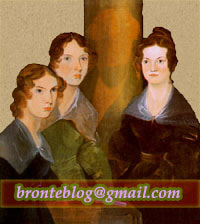Classic FM lists some historical figures you didn't know were classically trained musicians:
Emily Brontë (1818-1838)
As well as being a poet and writer of the novel Wuthering Heights, English author Emily Brontë was a pianist. She learned the instrument and practised in the home, as many did in those days, and she also taught the piano – both while she herself was still studying, and into adulthood. (Rosie Pentreath)
The West Australian talks about the exhibition
Writers Revealed: Treasures from the British Library and National Portrait Gallery, London you can see in Gold Coast, Queensland where the Pillar Portrait and the
Jane Eyre manuscript can be seen. A rare and extraordinary opportunity for Australian Brontë aficionados:
A world-first exhibition has opened on Australian shores featuring literary treasures all the way from England.
Gold Coast gallery HOTA (Home of the Arts) is hosting Writers Revealed: Treasures from the British Library and National Portrait Gallery, London from now until August 3.
The unprecedented exhibition features world-famous portraits and rare manuscripts from literary legends including William Shakespeare, Jane Austen, the Bronte sisters, William Blake and Virginia Woolf, to name a few. (Megan French)
India Today and writers and pseudonyms featuring all three Bell brothers. A quiz in
Borepanda on what you know about famous books includes this question:
20. Is it true or false that in Jane Eyre, Mr. Rochester is already married when he proposes to Jane? (Gerda K. and Erika Saikovskytė)
The Cut,
Vogue and
Thought Catalog seem to be fascinated by Heathcliff's gold tooth as featured by Jacob Elordi in the pictures of the
Wuthering Heights 2026 shooting published recently:
While it seems gold fillings were invented by the 1800s, when Wuthering Heights is set (Brontë’s version, at least), they were extremely rare and used only for the richest of the rich. By the time Fennell’s Heathcliff was casually sporting a little gold tooth, they were only just being introduced across the pond. Seems like his dentist was very connected. Maybe that’s the story worth telling? (Brooke LaMantia)
Sorry to get all lit-nerd right after making fun of my fellow English majors, but if there’s one thing that feels central to the story of Wuthering Heights, it’s the fact that Heathcliff is supposed to be…hot! Life-ruiningly, psyche-invadingly, genre-definingly hot! No offense to Elordi, who is certainly as handsome and symmetrical as you might expect an A-list actor to be, but in the first glimpses we’re getting, his big, goofy grin, mutton chops, and gold tooth (!) just don’t evoke the wildness and sexual magnetism of Heathcliff’s character for me. Sorry! (Emma Specter)
Times of India lists several Bollywood takes on literary masterpieces:
'Dil Diya Dard Liya' (1966) is a vintage Bollywood interpretation of Emily Brontë’s Wuthering Heights. It Indianised the moorland drama into a tale of passion and vengeance, resonating with Hindi cinema’s love for melodrama. Despite changes, the emotional intensity stayed true to the original novel’s stormy spirit. (Sonal Khandelwal)
Almost every dramatisation of great wealth depicts the people who possess it as monstrous or pitiable. From the Roy family in Succession to the biopic about Barbara Hutton, Poor Little Rich Girl, we’re invited to think of the rich as inadequate, unhappy people. In the same vein, Charlotte Brontë’s Jane Eyre, Charles Dickens’ Pip and Anthony Trollope’s Septimus Harding are all far kinder than the affluent folk who surround them. (Rowan Pelling)
Also in
The Telegraph a discussion of Charles Dickens's take on religion following the general release of the film
The King of Kings.
People who use religion as an excuse for cruelty are satirised by Dickens in the form of the Murdstones in David Copperfield; David recalls going to church with Miss Murdstone as a boy, she “mumbling the responses, and emphasising all the dread words with a cruel relish … If I move a finger or relax a muscle of my face, [she] pokes me with her prayer-book, and makes my side ache.” This is not at the level of the terrifying cruelty carried out in the name of religion by, say, the schoolmaster Mr Brocklehurst in Jane Eyre, but in its low-key way it reminds us how easily religious hypocrisy can make a child’s life a misery. (Jake Kerridge)









0 comments:
Post a Comment